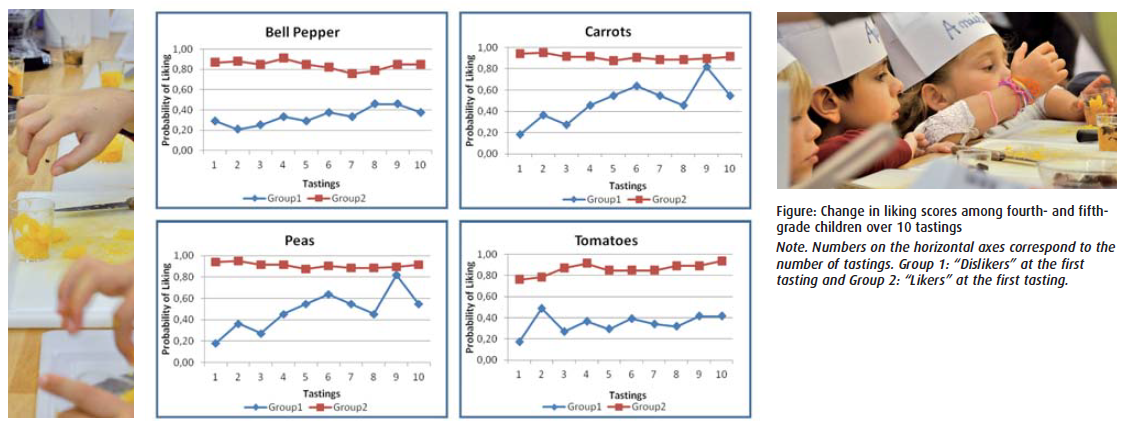Repeated taste exposure increases liking for vegetables by low-income elementary school children
Children’s food preferences are known to be key determinants of their consumption1. Frequent experience with foods through sight, smell, and taste is critical to achieving acceptance of these items by children2. Repeated taste exposures and modeling of healthy behaviors have been found to be effective in improving food preferences in children3,4; however, investigations conducted in public elementary school settings are very limited. It is important to demonstrate the effectiveness of food tasting in settings where children make food choices such as school cafeterias. In the present study we examined if repeated tastings of selected vegetables in school cafeterias increased children’s liking of these items.
Cafeteria vegetable tasting
Fourth and fifth grade students attending four elementary schools volunteered to participate. The program began with four consecutive weeks of tasting, followed by a three week break and was halted for three weeks due to school vacations and concluded by six additional weeks of tasting. On the same day and at the same time every week children were offered small samples of freshly prepared vegetables in the cafeteria with their regular lunch. The cold vegetables served included one baby carrot, a small piece of tomato and one-half tablespoon of diced green bell pepper. The hot vegetable included a one-half tablespoon serving of cooked canned green peas without any seasoning. Hot and cold vegetables were served in separate containers. Researchers directed the children to taste the vegetables using a standard script. Children completed a short survey indicating whether they swallowed the vegetable, spat it into the napkin, or did not put it in their mouth, and also recorded their liking for each vegetable after each tasting (5). The responses “swallowed the vegetable” and “spat it into the napkin” were considered as tasting that particular vegetable. If a child refused to taste any of the four vegetables, he/she did not receive a score for that vegetable for that particular day of tasting.
Repeated tasting increased children’s liking of vegetables
Three hundred and forty-eight children tasted at least one vegetable during the first or second opportunity to taste and were divided into two groups based upon their first response: Group 1 included those children who indicated that they “did not like” a particular vegetable and group 2 included those children who reported an opinion of either “liked” or “liked a lot” for the particular vegetable. The children’s liking scores in the two groups were followed over the 10 tasting sessions for each vegetable.
The liking scores improved for carrots, peas, and tomatoes in group 1 but there was no change for bell peppers. Children reported 5.5 times higher liking scores for carrots, 5.6 times higher liking scores for peas, and 2.8 times higher liking scores for tomatoes at T10 when compared to their liking score at T1. In group 2 children no change was observed in liking scores. The greatest percentage of children reported a change in opinion to liking or liking a lot by the eighth tasting for bell peppers and tomatoes and by the ninth tasting for carrots and peas.
Conclusions
Repeated taste exposures to targeted vegetables increased children’s liking for these foods. Eight to nine tastings may be necessary to impact the maximum number of children. The study procedure can be easily adopted by elementary schools and parents as a means to increase children’s liking and acceptance of vegetables. However future studies should address the most effective age for intervention and the impact of greater liking on actual vegetable consumption.

References
- Birch LL. Annu Rev Nutr. 1999; 19:41-62.
- Birch LL. Ann New York Acad Sci 1989; 561:209-216.
- Wardle J et al. Appetite 2003; 40:155-162.
- Horne PJ et al. European Journal of Clinical Nutrition 2004; 58:1649-1660.
- Lakkakula A et al. Appetite 2010; 55:226-231.
